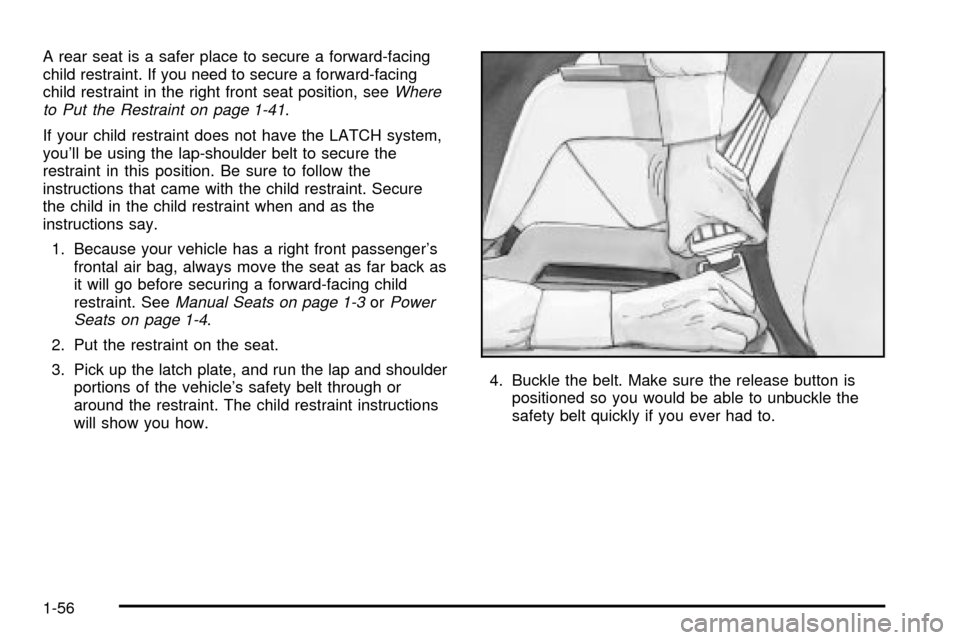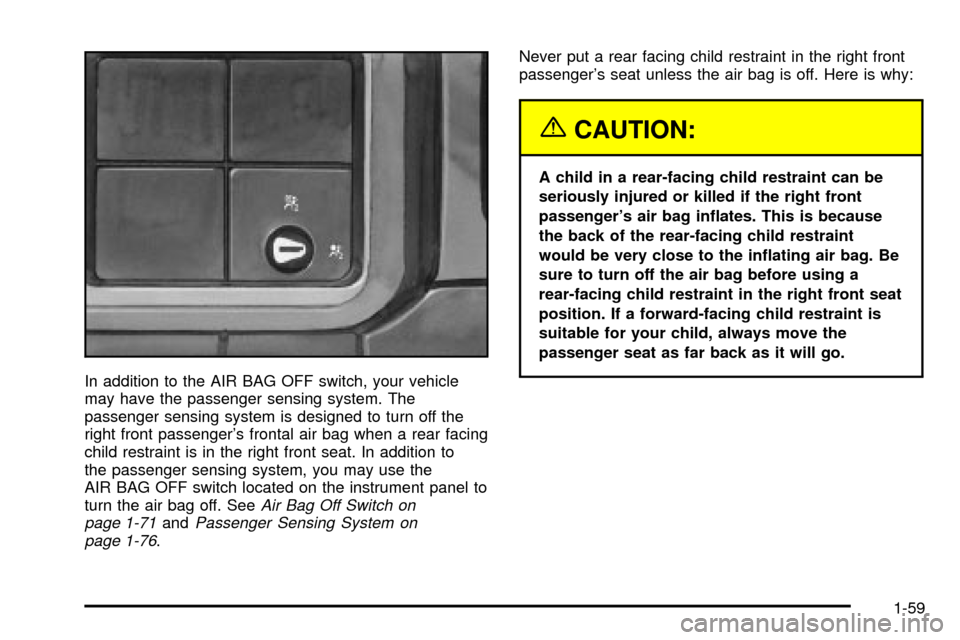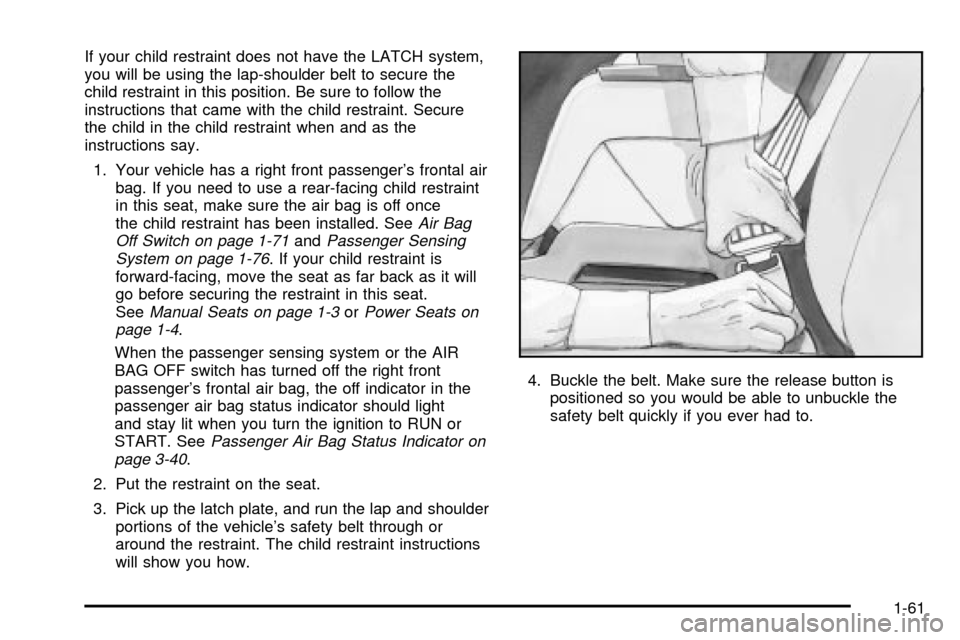Page 61 of 556
Securing a Child Restraint in the
Center Front Seat Position
Don't use child restraints in this position. The restraints
won't work properly.
Securing a Child Restraint in the
Right Front Seat Position
(Crew Cab Models)
If your child restraint is equipped with the LATCH
system, seeLower Anchorages and Top Tethers for
Children (LATCH System) on page 1-47. SeeTop Strap
on page 1-42if your child restraint has one.Your vehicle has a right front passenger air bag.
Neverput a rear-facing child restraint in the right front
passenger's seat. Here's why:
{CAUTION:
A child in a rear-facing child restraint can be
seriously injured or killed if the right front
passenger's air bag in¯ates. This is because
the back of the rear-facing child restraint
would be very close to the in¯ating air bag.
Always secure a rear-facing child restraint in a
rear seat.
1-55
Page 62 of 556

A rear seat is a safer place to secure a forward-facing
child restraint. If you need to secure a forward-facing
child restraint in the right front seat position, see
Where
to Put the Restraint on page 1-41.
If your child restraint does not have the LATCH system,
you'll be using the lap-shoulder belt to secure the
restraint in this position. Be sure to follow the
instructions that came with the child restraint. Secure
the child in the child restraint when and as the
instructions say.
1. Because your vehicle has a right front passenger's
frontal air bag, always move the seat as far back as
it will go before securing a forward-facing child
restraint. See
Manual Seats on page 1-3orPower
Seats on page 1-4.
2. Put the restraint on the seat.
3. Pick up the latch plate, and run the lap and shoulder
portions of the vehicle's safety belt through or
around the restraint. The child restraint instructions
will show you how.4. Buckle the belt. Make sure the release button is
positioned so you would be able to unbuckle the
safety belt quickly if you ever had to.
1-56
Page 64 of 556

To remove the child restraint, just unbuckle the vehicle's
safety belt and let it go back all the way. The safety
belt will move freely again and be ready to work for an
adult or larger child passenger.
Securing a Child Restraint in the
Right Front Seat Position (Regular
and Extended Cab Models)
Your vehicle has a right front passenger air bag. There
is a switch on the instrument panel that you can use
to turn off the right front passenger's air bag when you
need to secure a rear-facing child restraint at the
right front passenger's position. See the following
illustration. Your switch may vary slightly. See
Air Bag
Off Switch on page 1-71for more on this, including
important safety information and illustrations of alternate
switch designs.
{CAUTION:
A child in a rear-facing child restraint can be
seriously injured or killed if the right front
passenger's air bag in¯ates. This is because
the back of the rear facing child restraint
would be very close to the in¯ating air bag. Be
sure the air bag is off before using a
rear-facing child restraint in the right front seat
position.
Even though the Passenger Sensing System
and/or AIR BAG OFF switch are designed to
turn off the passenger's frontal air bag under
certain conditions, no system is fail-safe, and
no one can guarantee that an air bag will not
deploy under some unusual circumstance,
even though it is turned off. General Motors
therefore recommends that rear-facing child
restraints be transported in vehicles with a
rear seat that will accommodate a rear-facing
child restraint, whenever possible.
1-58
Page 65 of 556

In addition to the AIR BAG OFF switch, your vehicle
may have the passenger sensing system. The
passenger sensing system is designed to turn off the
right front passenger's frontal air bag when a rear facing
child restraint is in the right front seat. In addition to
the passenger sensing system, you may use the
AIR BAG OFF switch located on the instrument panel to
turn the air bag off. See
Air Bag Off Switch on
page 1-71andPassenger Sensing System on
page 1-76.Never put a rear facing child restraint in the right front
passenger's seat unless the air bag is off. Here is why:
{CAUTION:
A child in a rear-facing child restraint can be
seriously injured or killed if the right front
passenger's air bag in¯ates. This is because
the back of the rear-facing child restraint
would be very close to the in¯ating air bag. Be
sure to turn off the air bag before using a
rear-facing child restraint in the right front seat
position. If a forward-facing child restraint is
suitable for your child, always move the
passenger seat as far back as it will go.
1-59
Page 66 of 556

A rear seat is a safer place to secure a forward facing
child restraint. SeeWhere to Put the Restraint on
page 1-41. If you need to secure a forward-facing child
restraint in the right front seat position, move the
seat as far back as it will go before securing a
forward-facing child restraint. See
Manual Seats on
page 1-3orPower Seats on page 1-4.
{CAUTION:
If the air bag readiness light in the instrument
panel cluster ever comes on when you have
turned off the air bag, it means that something
may be wrong with the air bag system. The
right front passenger's air bag could in¯ate
even though the switch is off. If this ever
happens, have the vehicle serviced promptly.
Until you have the vehicle serviced, do not let
CAUTION: (Continued)
CAUTION: (Continued)
anyone whom the national government has
identi®ed as a member of a passenger air bag
risk group sit in the right front passenger's
position (for example, do not secure a
rear-facing child restraint in the right front
passenger's seat). See²Air Bag Off Switch²in
the Index.
In addition to the AIR BAG OFF switch, your vehicle
may have the passenger sensing system. See
Passenger Sensing System on page 1-76for more on
this, including important safety information.
If your child restraint is equipped with the LATCH
system, see
Lower Anchorages and Top Tethers for
Children (LATCH System) on page 1-47. SeeTop Strap
on page 1-42if your child restraint has one.
1-60
Page 67 of 556

If your child restraint does not have the LATCH system,
you will be using the lap-shoulder belt to secure the
child restraint in this position. Be sure to follow the
instructions that came with the child restraint. Secure
the child in the child restraint when and as the
instructions say.
1. Your vehicle has a right front passenger's frontal air
bag. If you need to use a rear-facing child restraint
in this seat, make sure the air bag is off once
the child restraint has been installed. See
Air Bag
Off Switch on page 1-71andPassenger Sensing
System on page 1-76. If your child restraint is
forward-facing, move the seat as far back as it will
go before securing the restraint in this seat.
See
Manual Seats on page 1-3orPower Seats on
page 1-4.
When the passenger sensing system or the AIR
BAG OFF switch has turned off the right front
passenger's frontal air bag, the off indicator in the
passenger air bag status indicator should light
and stay lit when you turn the ignition to RUN or
START. See
Passenger Air Bag Status Indicator on
page 3-40.
2. Put the restraint on the seat.
3. Pick up the latch plate, and run the lap and shoulder
portions of the vehicle's safety belt through or
around the restraint. The child restraint instructions
will show you how.4. Buckle the belt. Make sure the release button is
positioned so you would be able to unbuckle the
safety belt quickly if you ever had to.
1-61
Page 69 of 556

8. If your vehicle has the passenger sensing system
and you are using a rear-facing child restraint in
this seat, check to be sure the right front
passenger's frontal air bag is off before you begin
to drive. If the air bag is off, the off indicator
will be lit and stay lit in the inside rearview mirror
when the key is turned to RUN or START.
If the on indicator is lit, the passenger's frontal air bag
has not been turned off by the passenger sensing
system. If this ever happens, turn the vehicle off,
unbuckle the safety belt and perform the steps to install
the rear-facing restraint again. If the air bag still does
not turn off, check to make sure the AIR BAG OFF
switch has been turned to the off position or install the
infant restraint in a rear seat position if one is
available. See
Air Bag Off Switch on page 1-71for more
on this, including important safety information.
For heavy duty pickups without the passenger sensing
system, use the AIR BAG OFF switch to turn the air
bag off or install the infant restraint in a rear seat
position.
{CAUTION:
If the air bag ON indicator comes on when you
have a rear-facing child restraint installed in
the right front passenger's seat, it means that
the passenger sensing system has not turned
off the passenger's frontal air bag. A child in a
rear-facing child restraint can be seriously
injured or killed if the right front passenger's
air bag in¯ates. This is because the back of
the rear-facing child restraint would be very
close to the in¯ating air bag. Don't use a
rear-facing child restraint in the right front
passenger's seat unless the air bag is off.
1-63
Page 79 of 556

This switch should only be turned to AIR BAG OFF if
the person in the right front passenger's position is
a member of a passenger risk group identi®ed by the
national government as follows:
Infant. An infant (less than 1 year old)
must ride in the front seat because:
·
my vehicle has no rear seat;
·my vehicle has a rear seat too small to
accommodate a rear-facing infant seat; or
·the infant has a medical condition which, according
to the infant's physician, makes it necessary for the
infant to ride in the front seat so that the driver
can constantly monitor the child's condition.
Child age 1 to 12. A child age 1 to 12 must
ride in the front seat because:
·
my vehicle has no rear seat;
·although children ages 1 to 12 ride in the rear
seat(s) whenever possible, children ages 1 to 12
sometimes must ride in the front because no space
is available in the rear seat(s) of my vehicle; or
·the child has a medical condition which, according
to the child's physician, makes it necessary for the
child to ride in the front seat so that the driver
can constantly monitor the child's condition. Canada without Passenger Sensing System
1-73